The developer's guide to browser adoption rates
As new platform versions get released more and more quickly, are users keeping up? Zeh Fernando, a senior developer at Firstborn, looks at current adoption rates and points to some intriguing trends
There's a quiet revolution happening on the web, and it's related to one aspect of the rich web that is rarely discussed: the adoption rate of new platform versions.
First, to put things into perspective, we can look at the most popular browser plug-in out there: Adobe's Flash Player. It's pretty well known that the adoption of new versions of the Flash plug-in happens pretty quickly: users update Flash Player quickly and often after a new version of the plug-in is released [see Adobe's sponsored NPD, United States, Mar 2000-Jun 2006, and Milward Brown’s “Mature markets”, Sep 2006-Jun 2011 research (here and here) collected by way of the Internet Archive and saved over time; here’s the complete spreadsheet with version release date help from Wikipedia].
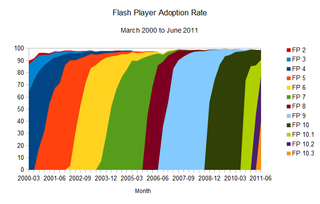
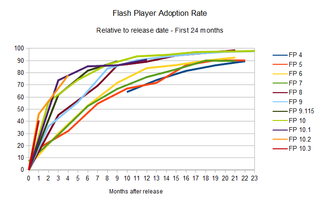
To simplify it: give it around eight months, and 90 per cent of the desktops out there will have the newest version of the plug-in installed. And as the numbers represented in the charts above show, this update rate is only improving. That’s party due to the fact that Chrome, now a powerful force in the browser battles, installs new versions of the Flash Player automatically (sometimes even before it is formally released by Adobe), and that Firefox frequently detects the user's version and insists on them installing an updated, more secure version.
Gone are the days where the Flash platform needed an event such as the Olympics or a major website like MySpace or YouTube making use of a new version of Flash to make it propagate faster; this now happens naturally. Version 10.3 only needed one month to get to a 40.5 per cent install base, and given the trends set by the previous releases, it's likely that the plug-in's new version 11 will break new speed records.
Any technology that can allow developers and publishers to take advantage of it in a real world scenario so fast has to be considered a breakthrough. Any new platform feature can be proposed, developed, and made available with cross-platform consistency in record time; such is the advantage of a proprietary platform like Flash. To mention one of the more adequate examples of the opposite effect, features added to the HTML platform (in any of its flavours or versions) can take many years of proposal and beta support until they're officially accepted, and when that happens, it takes many more years until it becomes available on most of the computers out there. A plug-in is usually easier and quicker to update than a browser too.
That has been the story so far. But that's changing.
Google Chrome adoption rate
Looking at the statistics for the adoption rate of the Flash plug-in, it's easy to see it's accelerating constantly, meaning the last versions of the player were finding their way to the user's desktops quicker and quicker with every new version. But when you have a look at similar adoption rate for browsers, a somewhat similar but more complex story unfolds.
Get the Creative Bloq Newsletter
Daily design news, reviews, how-tos and more, as picked by the editors.
Let's have a look at Google Chrome's adoption rates in the same manner I've done the Flash player comparisons, to see how many people had each of its version installed (but notice that, given that Chrome is not used by 100 per cent of the people on the internet, it is normalised for the comparison to make sense).
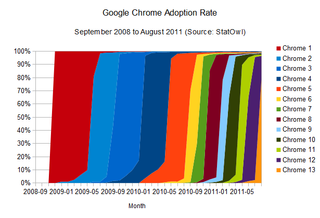
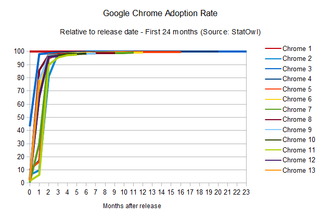
The striking thing here is that the adoption rate of Google Chrome manages to be faster than Flash Player itself [see StatOwl's web browser usage statistics, browser version release dates from Google Chrome on Wikipedia]. This is helped, of course, by the fact that updates happens automatically (without user approval necessary) and easily (using its smart diff-based update engine to provide small update files). As a result, Chrome can get to the same 90 per cent of user penetration rate in around two months only; but what it really means is that Google manages to put out updates to their HTML engine much faster than Flash Player.
Of course, there's a catch here if we're to compare that to Flash Player adoption rate: as mentioned, Google does the same auto-update for the Flash Player itself. So the point is not that there's a race and Chrome's HTML engine is leading it; instead, Chrome is changing the rules of the game to not only make everybody win, but to make them win faster.
Opera adoption rate
The fast update rate employed by Chrome is not news. In fact, one smaller player on the browser front, Opera, tells a similar story.
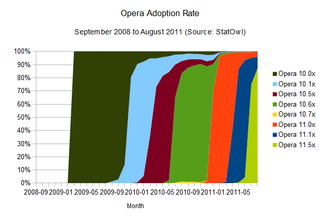
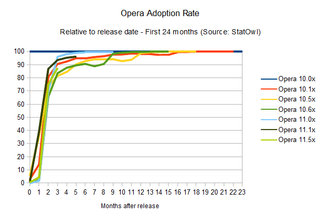
Opera also manages to have updates reach a larger audience very quickly [see browser version release dates from History of the Opera web browser, Opera 10 and Opera 11 on Wikipedia]. This is probably due to its automatic update feature. The mass updates seem to take a little bit longer than Chrome, around three months for a 90 per cent reach, but it's important to notice that its update workflow is not entirely automatic; last time I tested, it still required user approval (and Admin rights) to work its magic.
Firefox adoption rate
The results of this browser update analysis start deviating when we take a similar look at the adoption rates of the other browsers. Take Firefox, for example:
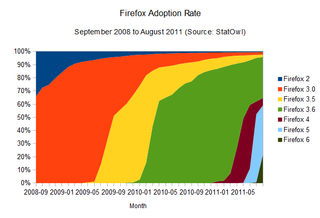
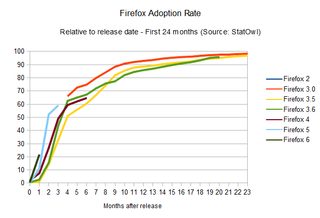
It's also clear that Firefox's update rate is accelerating (browser version release dates from Firefox on Wikipedia), and the time-to-90-per-cent is shrinking: it should take around 12 months to get to that point. And given Mozilla's decision to adopt release cycles that mimics Chrome's, with its quick release schedule, and automatic updates, we're likely to see a big boost in those numbers, potentially making the update adoption rates as good as Chrome's.
One interesting point here is that a few users seem to have been stuck with Firefox 3.6, which is the last version that employs the old updating method (where the user has to manually check for new versions), causing Firefox updates to spread quickly but stall around the 60 per cent mark. Some users still need to realise there's an update waiting for them; and similarly to the problem the Mozilla team had to face with Firefox 3.5, it's likely that we'll see the update being automatically imposed upon users soon, although they'll still be able to disable it. It's gonna be interesting to see how this develops over the next few months.
What does Apple's Safari look like?
Safari adoption rate
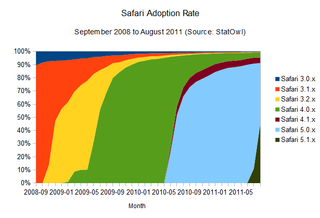
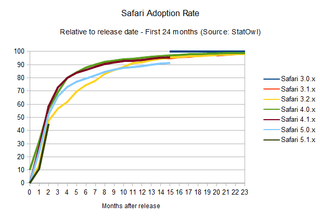
Right now, adoption rates seem on par with Firefox (browser version release dates from Safari on Wikipedia), maybe a bit better, since it takes users around 10 months to get a 90 per cent adoption rate of the newest versions of the browser. The interesting thing is that this seems to happen in a pretty solid fashion, probably helped by Apple's OS X frequent update schedule, since the browser update is bundled with system updates. Overall, update rates are not improving – but they're keeping at a good pace.
Notice that the small bump on the above charts for Safari 4.0.x is due to the public beta release of that version of the browser, and the odd area for Safari 4.1.x is due to its release in pair with Safari 5.0.x, but for a different version of OSX.
IE adoption rate
All in all it seems to me that browser vendors, as well as the users, are starting to get it. Overall, updates are happening faster and the cycle from interesting idea to a feature that can be used on a real-world scenario is getting shorter and shorter.
There's just one big asterisk in this prognosis: the adoption rate for the most popular browser out there.
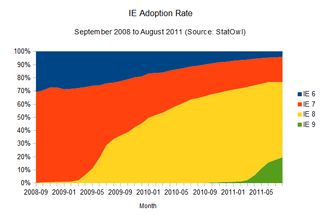
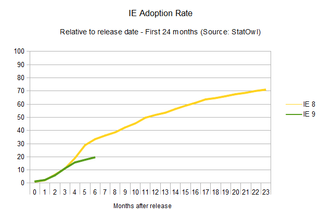
The adoption rate of updates to Internet Explorer is not improving at all (browser version release dates from Internet Explorer on Wikipedia). In fact, it seems to be getting worse.
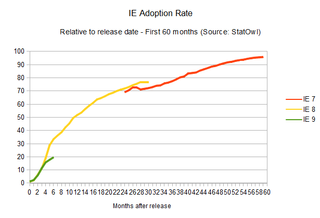
As is historically known, the adoption rate of new versions of Internet Explorer is, well, painstakingly slow. IE6, a browser that was released 10 years ago, is still used by four per cent of the IE users, and newer versions don't fare much better. IE7, released five years ago, is still used by 19 per cent of all the IE users. The renewing cycle here is so slow that it's impossible to even try to guess how long it would take for new versions to reach a 90 per cent adoption rate, given the lack of reliable data. But considering update rates haven't improved at all for new versions of the browser (in fact, IE9 is doing worse than IE8 in terms of adoption), one can assume a cycle of four years until any released version of Internet Explorer reaches 90 per cent user adoption. Microsoft itself is trying to make users abandon IE6, and whatever the reason for the version lag – system administrators hung up on old versions, proliferation of pirated XP installations that can't update – it's just not getting there.
And the adoption rates of new HTML features is, unfortunately, only as quick as the adoption rate of the slowest browser, especially when it's someone that still powers such a large number of desktops out there.
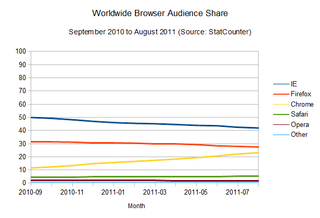
Internet Explorer will probably continue to be the most popular browser for a very long time.
The long road for HTML-based tech
The story, so far, has been that browser plug-ins are usually easier and quicker to update. Developers can rely on new features of a proprietary platform such as Flash earlier than someone who uses the native HTML platform could. This is changing, however, one browser at a time.
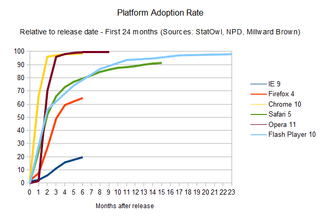
A merged chart, using the weighted distribution of each browser's penetration and the time it takes for its users to update, tells that the overall story for HTML developers still has a long way to go.
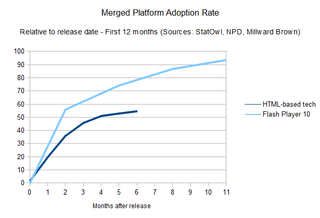
Of course, this shouldn't be taken into account blindly. You should always have your audience in mind when developing a website, and come up with your own numbers when deciding what kind of features to make use of. But it works as a general rule of thumb to be taken into account before falling in love with whatever feature has just been added to a browser's rendering engine (or a new plug-in version, for that matter). In that sense, be sure to use websites like caniuse.com to check on what's supported (check the “global user stats” box!), and look at whatever browser share data you have for your audience (and desktop/mobile share too, although it's out of the scope of this article).
Conclusion
Updating the browser has always been a certain roadblock to most users. In the past, even maintaining bookmarks and preferences when doing an update was a problem.
That has already changed. With the exception of Internet Explorer, browsers vendors are realising how important it is to provide easy and timely updates for users; similarly, users themselves are, I like to believe, starting to realise how an update can be easy and painless too.
Personally, I used to look at the penetration numbers of Flash and HTML in comparison to each other and it always baffled me how anyone would compare them in a realistic fashion when it came down to the speed that any new feature would take to be adopted globally. Looking at them this time, however, gave me a different view on things; our rich web platforms are not only getting better, but they're getting better at getting better, by doing so faster.
In retrospect, it seems obvious now, but I can only see all other browser vendors adopting similar quick-release, auto-update features similar to what was introduced by Chrome. Safari probably needs to make the updates install without user intervention, and we can only hope that Microsoft will consider something similar for Internet Explorer. And when that happens, the web, both HTML-based and plug-ins-based but especially on the HTML side, will be moving at a pace that we haven't seen before. And everybody wins with that.

Thank you for reading 5 articles this month* Join now for unlimited access
Enjoy your first month for just £1 / $1 / €1
*Read 5 free articles per month without a subscription

Join now for unlimited access
Try first month for just £1 / $1 / €1
The Creative Bloq team is made up of a group of design fans, and has changed and evolved since Creative Bloq began back in 2012. The current website team consists of eight full-time members of staff: Editor Georgia Coggan, Deputy Editor Rosie Hilder, Ecommerce Editor Beren Neale, Senior News Editor Daniel Piper, Editor, Digital Art and 3D Ian Dean, Tech Reviews Editor Erlingur Einarsson and Ecommerce Writer Beth Nicholls and Staff Writer Natalie Fear, as well as a roster of freelancers from around the world. The 3D World and ImagineFX magazine teams also pitch in, ensuring that content from 3D World and ImagineFX is represented on Creative Bloq.
